Embarking on the journey of effective leadership? Discover the transformative power of soft skills for managers.
Years ago, soft skills were considered optional. If you had great people skills, it was a nice bonus on top of your work experience. Competency was king.
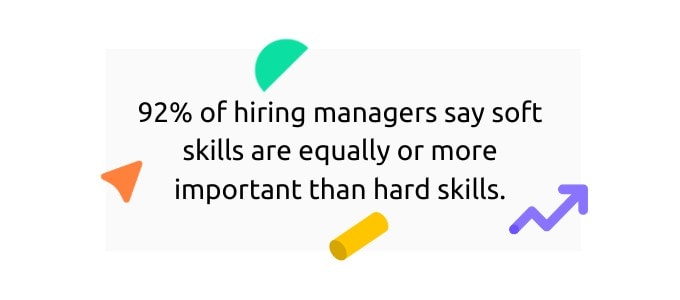
There’s no excuse to neglect your soft skills in the modern workplace. The most effective leaders invest in emotional intelligence, communication, and listening ability.
92% of hiring managers say that soft skills are equally (or more) important than hard skills and work experience.
The soft skills gap has proven the need for more focus on communication skills and professionalism. 44% of executives think Americans need more soft skills to do their jobs well.
You might be the best in the world at the technical parts of your job. But if you lack soft skills, you’re limited to what you can do alone. That’s not leadership.
We often think of soft skills as part of personality. You’ve probably said and heard statements like “he’s a people person” or “she’s a born leader.”
Technical skills are more straightforward, but soft skills are just as critical. The truth is that interpersonal skills, leadership ability, and every other soft skill can be taught. You can devote time to doing some soft skills training.
Boost your team’s efficiency with Hubstaff's productivity tools
Why soft skills improve the quality of management
You can be the best in the world at the technical parts of your job. But if you don’t lead well, you’re limited to the things you can do alone. You need soft skills to get things done as a team.
Managers with outstanding leadership soft skills can boost their team’s productivity by up to 30 percent.
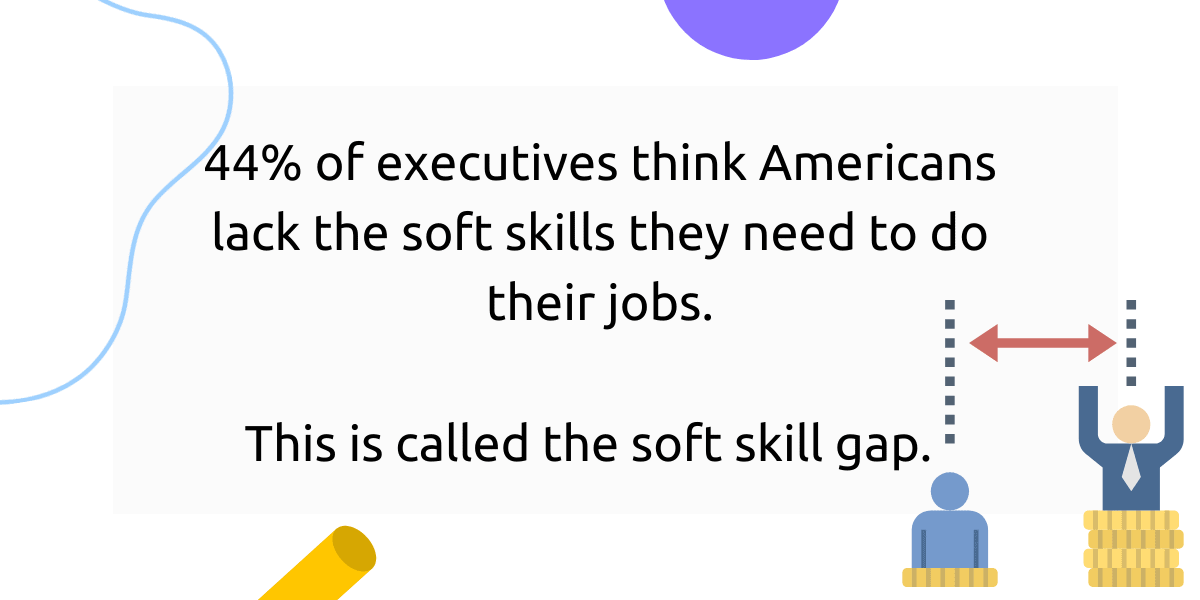
These skills also make your job easier. You set an example for your team. They’ll do the same when you communicate better, show more patience, and stay positive through challenges.
Of course, not all soft skills are people-focused.
The willingness and ability to learn new things is a soft skill that helps you level up your technical ability. Problem-solving, organization, and time management are also considered critical soft skills.
Business leaders who develop soft skills can boost their team’s productivity by up to 30%. There’s nothing soft about that.
What are the most essential soft skills for managers?
They’re all important, of course. There’s no perfect set of skills that works for everyone.
If you try to learn everything at once, you’ll end up frustrated and just as unskilled as you were before. Focus on your strengths and most significant weaknesses. Learn one thing at a time so that you can invest the energy and focus you need to develop that skill.
Talk to your team to find out what they need from you, and use this list to help you get started.
Crucial soft skills for managers
1. Collaboration

Collaboration is the ability to work with other people.
As a manager, working with others is one of the biggest parts of your job. Your team will struggle to get things done if you lack this skill.
The ability to work as part of a team is a minimum requirement for managers.
Don’t stop there.
Keep building your collaboration skills to level up your leadership ability.
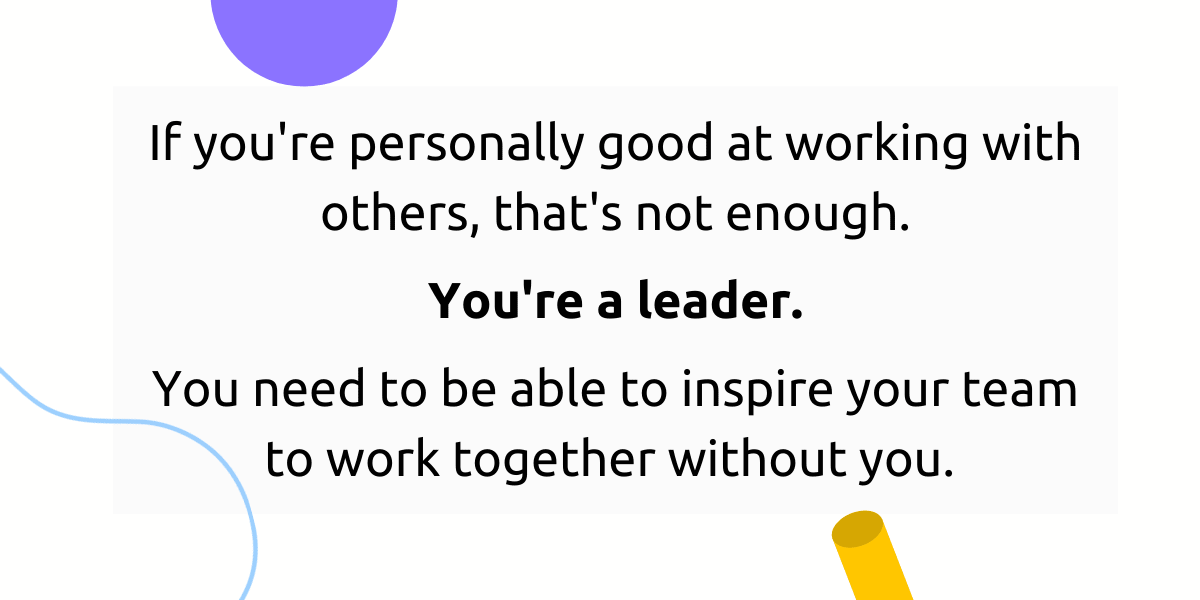
This is one of the core skills you need to develop transparent leadership. Including your team proves that you trust and value them. You’ll have a better perspective when making important decisions, and your team will be better equipped to solve problems without your help.
It’s not enough to be personally good at working with others. You’re a leader. On top of your skills, it’s essential to encourage your team to collaborate. After all, you won’t always be around to guide the conversation.
How to be a better team player
Like all skills, getting better at collaboration takes a conscious effort. You have to think about it.
Open up to your team and explain that you want to get better at working collaboratively. Ask them to call it to your attention when you aren’t living up to your commitment.
Talking about what you want to accomplish is a good habit if you want to get better at collaboration. People can’t work with you if they don’t know what you’re working on. Practice being more open.
Remember that this is a two-way street.
If you tell your team what to do and they get it done, that is not collaboration. Stay open to feedback and be willing to change course when someone comes up with a better solution.
That means listening skills are vital, too. And that brings us to the next soft skill on the list:
2. Communication

Has this ever happened to you? You have a meeting about an important new project. The team talks about it for hours, everyone gets their assignments, and you all get to work. Weeks go by, and everyone reports that work is ahead of schedule.
When everyone turns in their projects, though, it’s not what you expected. Some people misunderstood, and now you have to go back and fix those problems. You thought you were ahead, but now you’ll finish late because of communication issues.
Communication issues can be a minor inconvenience or be the reason a company fails. Most of the time, they’re somewhere in between. Soft skills enable managers to communicate effectively with their team, effective communication is a considerable advantage.
Your team becomes more productive. The company makes more profit. Morale increases, and you create a healthier work environment for everyone.
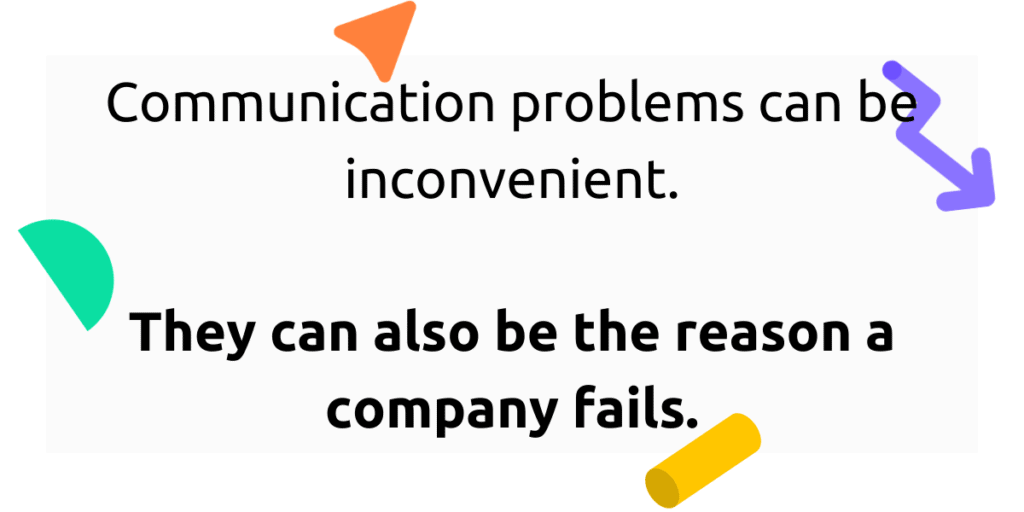
There are two sides to communication. If you want to become a better communicator, you need to work on both halves:
- Can you share ideas so that other people understand them?
- Do you understand the ideas that other people share with you?
If only one of those things is happening, you’re not communicating. Here’s how to get better at both:
Invite feedback
It’s essential to understand what’s going on with your team. That’s a big part of your job.
Encourage your employees and peers to share feedback about:
- You
- Their colleagues
- The business itself
Some managers try to avoid this. They’re uncomfortable receiving criticism and don’t want to encourage employees to complain.
However, the more you talk with team members, the faster you uncover conflicts and find opportunities.
Listen more, talk less
One of the best ways to improve your communication skills is to listen more. Focus on what the other person says instead of thinking about your next line.
Practice active listening.
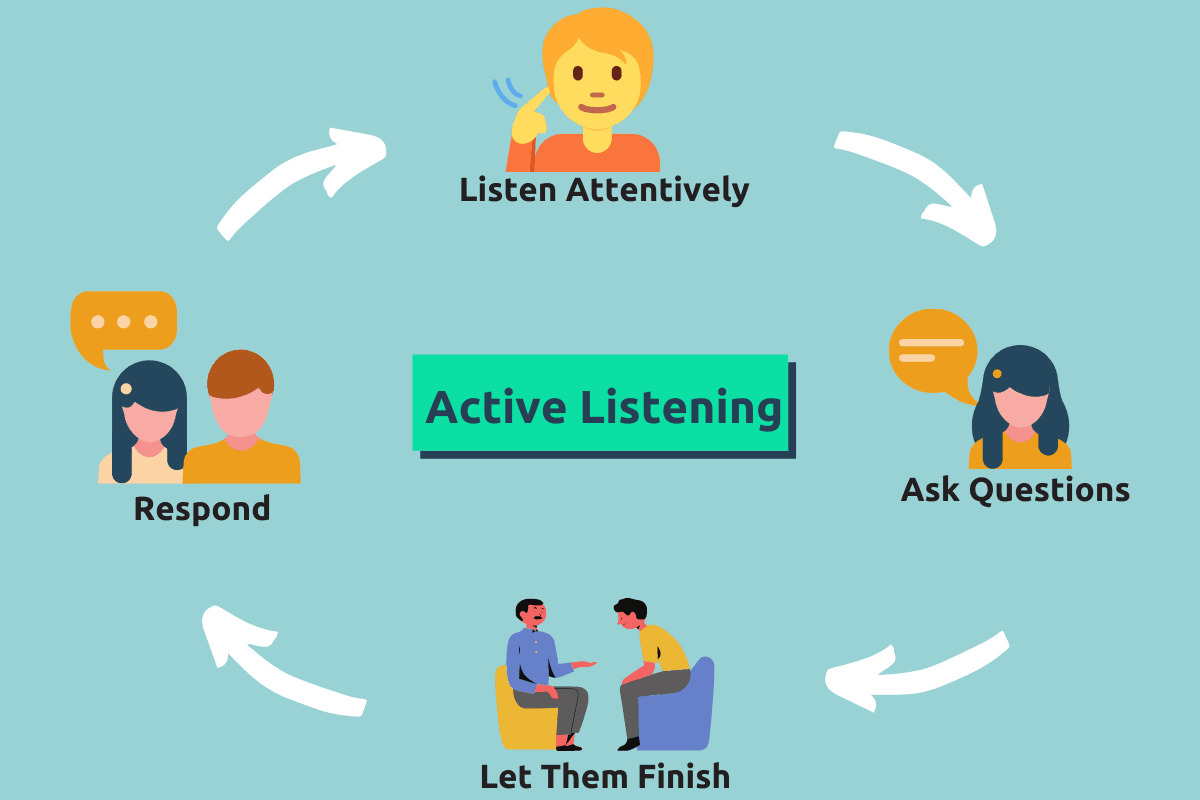
When you use active listening, focus all your energy on listening and understanding while someone else talks. Then, make sure that you both understand before you reply. It works like this:
- Listen with undivided attention. Do not think about how to reply — just focus on what is being said. Tip: if you struggle to focus on their words without your mind running away, try mentally repeating everything they say. It helps reinforce the point and makes step 2 easier.
- Repeat the main points and ask questions to clarify anything you don’t understand. For example, if an employee tells you about an unrealistic workload, you might say: “It sounds like there’s too much on your plate to meet all your deadlines. You mentioned that you’re responsible for a lot of administrative tasks. Can you tell me what those are?”
- Wait until the other person is done explaining before you think about responding. Continue asking questions and rephrasing key points until you reach the best understanding possible. This might take some time, especially in emotionally charged situations. Let the speaker talk themselves out. Often, the fact that you’re listening attentively helps calm them before you’ve even talked about a solution.
- Respond appropriately. They may bring up different points and start talking again. That’s okay. Use your active listening skills again. You’re still making progress.
Improve your subtext
Your body language and tone of voice add meaning to your words. When you don’t pay attention to them, you might send messages you don’t want to.
Maybe you’re trying to be tactful, so you choose your words carefully. However, you’re frustrated with the situation. Your words say you’re not angry, but your crossed arms and flat tone of voice say otherwise. Your team picks up on these cues and assumes you’re mad at them.
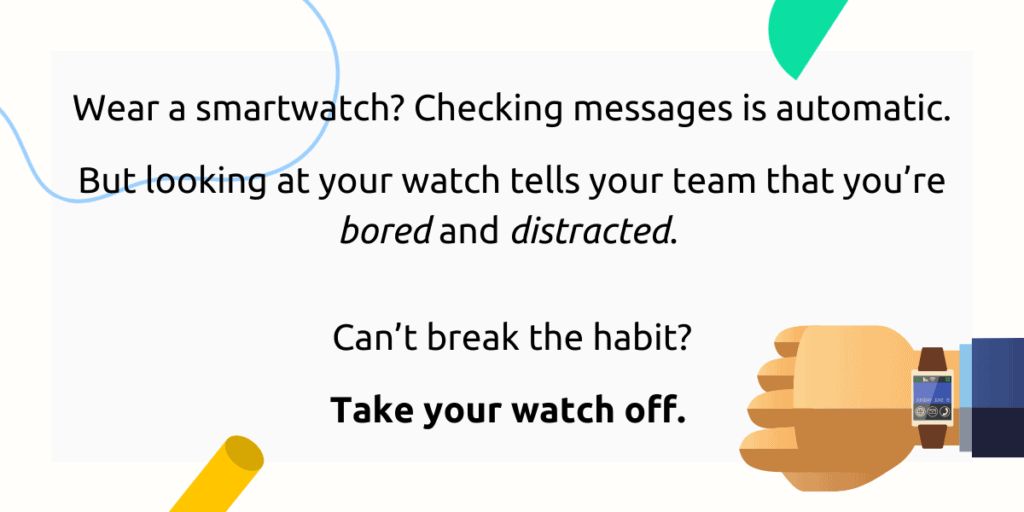
Pay attention to the nonverbal clues in your team as you listen to them. Noticing their tone and body language helps you become more aware of the signals you send. For example:
Crossed arms, frowns, and hunched shoulders all signal unhappiness and irritation.
Glancing at a smartwatch alert, checking your phone, or fidgeting tells people you’re bored and distracted.
Looking down, tapping your fingers, or bouncing your leg makes it seem like you’re nervous.
Watch for subtext when people speak to you AND when they listen. You can tell if you’re getting your point across by watching your listener’s body language.
Start by building more awareness of your subtext. Watch how you communicate and how people react to it. Modify your tone and body language from there when you realize it doesn’t match your message.
Use simple language
If you want everyone to understand you, keep it simple. Avoid using slang, jargon, and acronyms.
Industry-specific language may seem universal. However, there’s always a possibility that someone in the room doesn’t know what a CRM is.
Using jargon like this doesn’t benefit you and alienates people who haven’t learned those terms yet.
Most people won’t ask you what you’re talking about because they fear looking dumb. You think you’ve gotten your point across, but your team doesn’t know what you want them to do.
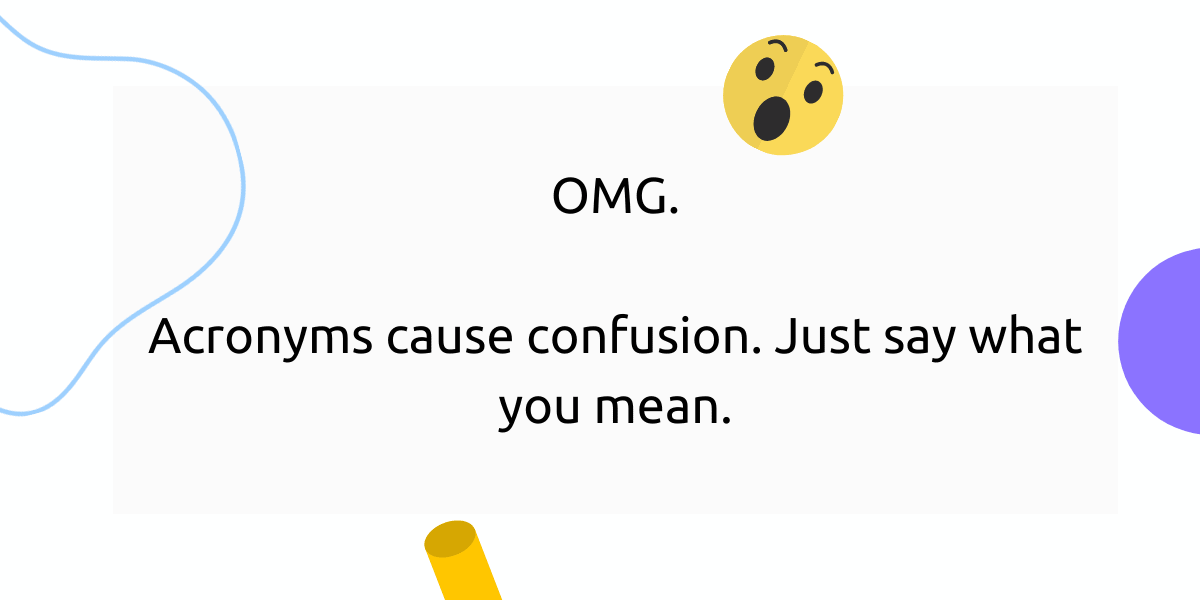
Keep it straightforward. Consider implementing an anti-acronym policy like the one at SpaceX. Elon Musk famously emailed all his employees to insist they stop using acronyms. He said:
“Keeping communication good as we grow is incredibly important. Individually, a few acronyms here and there may not seem so bad, but…over time, the result will be a huge glossary that we have to issue to new employees. No one can remember all these acronyms, and people don’t want to seem dumb in a meeting, so they just sit there in ignorance. This is particularly tough on new employees.”
Sometimes, you have to use technical language. For example, if you’re talking to a team of engineers about a complex project, they’ll expect you to know the correct terminology.
The key here is to match your language to your listener. If you think there’s a chance people won’t understand you, try phrasing a thought in multiple ways and use examples.
3. Empathy
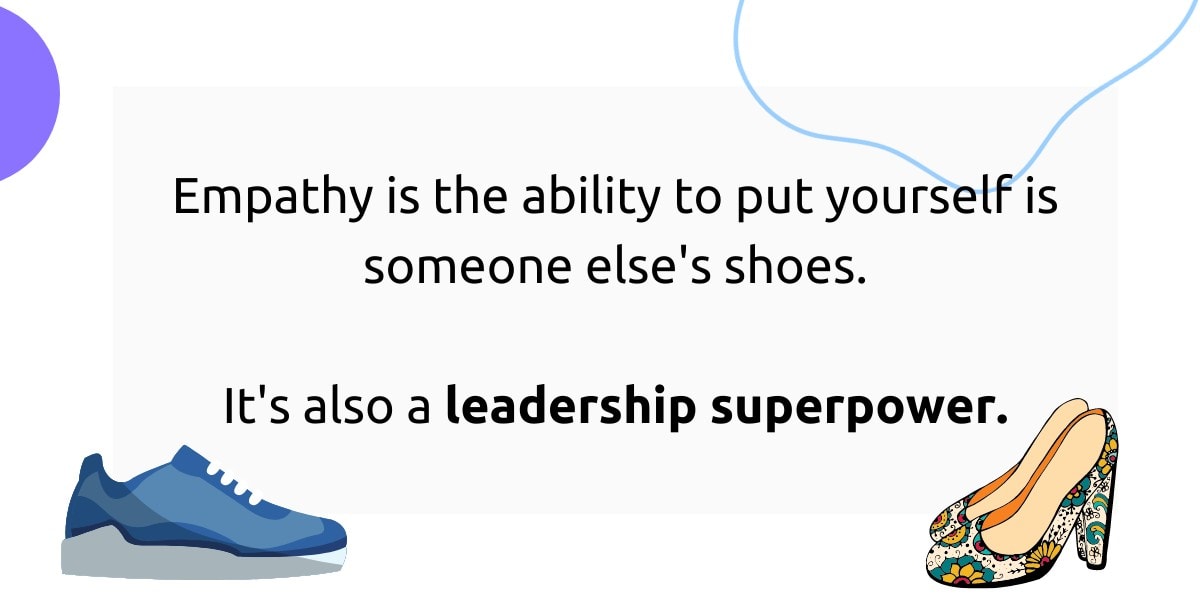
Empathy is the ability to understand other people’s emotions and perspectives. Think of it as being able to put yourself in someone else’s shoes.
This is a powerful soft skill for managers.
Think about it: if you can see things from your team’s perspective, you truly understand how they think and what they need from you. They can tell that you care. It’s easier to trust each other. You understand why people make different decisions, so you’re more patient with people.
All of this creates a happier, more engaged team. It’s also a leadership superpower when assigning work to the right people.
Become more empathetic
Developing empathy takes time and effort.
The most important way to build empathy is to ask other people about their perspectives. You’ll gradually build your empathy skills by listening more and understanding where people are coming from.
You won’t always get it right, but that’s okay. Keep working at it.
Here are some other things you should work on if you’re trying to become more empathetic.
Examine your biases
Everyone is biased. Since most of these preferences are unconscious, you can’t see them without looking for them. Admit that you have biases so that you can identify your blind spots.
Tests like the Implicit Association Test can help uncover your biases regarding race, religion, and gender. This test can also tell you if a bias is strong or slight.
Some of your biases might be conscious. For example, actively avoiding people with a particular political leaning is a conscious bias.
Most of your biases are subconscious. You don’t even realize that you tend to gravitate towards certain people or ideas and automatically reject others.
Everyone has biases. You don’t have to eliminate them to be a good leader — you just need to build awareness so that your biases don’t unfairly impact your team.
Figuring out those unconscious triggers is complex by nature. One of the best ways to identify your biases is to examine your feelings in different settings.
When you feel uncomfortable in a new situation, figure out what causes that. Pay attention when you feel annoyed or anxious around someone you just met.
Not all biases are negative. Next time you take an immediate liking to someone, consider what made you feel that way.
Put some thought into your biases and consider how they affect your job. Are you more likely to ask people for advice if they’re a certain age or gender? Do you find it easier to take criticism from people with a specific personality type?
From there, understand why you feel that way and how other people might feel differently. It’s tough, but that’s how you build empathy.
Become a volunteer
Volunteer organizations always need another helping hand. Look for opportunities to help out at:
- Homeless shelters
- Food pantries
- Retirement homes
- Religious organizations
- Animal shelters
- Medical research organizations

Volunteering is a great way to become more empathetic. As you spend time with people different from your peer group, you’re exposed to new ideas and different ways of thinking.
Some types of volunteering also help you relate to other people’s struggles. This can help you overcome some of your unconscious biases, too.
Read fiction
Multiple studies prove that reading fiction makes you more empathetic.
When you read a character-driven story, it’s like your brain experiences events as a different person. You feel what they feel and understand how they think.
This happens even if the character is someone you don’t relate with.
For example, if you’re a 38-year-old man from Algeria, you can still read To Kill a Mockingbird and understand things from the perspective of a 6-year-old Alabama girl.
If you want to develop empathy by reading, the best choices are character-driven novels. Choose a story with a perspective you don’t normally encounter.
You might have a lot of fun reading plot-driven spy thrillers, but they won’t help you develop empathy. These stories rely more on the events that create a conflict, while character-focused books rely on how people react to conflict.
Understanding the way people react is what empathy is all about.
Brian Dean, founder of Exploding Topics, states that reading fiction has helped him develop empathy for his remote team:
“Reading classic fiction, especially the work of Agatha Christie, has helped me understand human nature on a deeper level. Being character-driven stories, often told from several perspectives, has allowed me to see the same situation from different angles. And I often use her narrative approach to see events through my team member’s eyes.”
4. Emotional intelligence
Emotional intelligence (EI) is a must-have for leaders. It’s about understanding and handling your emotions and those of your team. Leaders with high emotional intelligence read emotions well, creating a positive workplace vibe.
Self-awareness
Self-awareness is a big part of your overall EI. Good leaders know their strengths, weaknesses, and how stress affects them. Being in tune with themselves helps them make better decisions and lead effectively.
Empathy
Empathy is another critical element of EI. It’s about getting where your team is coming from emotionally. Leaders who connect with their team build trust and strong relationships.
Emotional regulation
Then there’s regulating your emotions. Leaders who can keep their cool in challenging situations inspire confidence. They stay calm, think clearly, and make intelligent decisions. Developing emotional intelligence makes leaders effective and great to work with, creating a positive and productive work environment.
5. Flexibility
People aren’t robots.
What works for one person may not work for another. You may need to modify your management approach for each team member.
Adapt your management style to accommodate different personalities
Find out how your team members like to work and adapt your management style to their preferences.
For example, introverts might respond better to being praised privately. They may find it embarrassing to be the center of attention, even for kudos.
Extroverts, on the other hand, might enjoy the entire team hearing about their excellent work.
More creative types want to express their ideas. You can help them do this by organizing brainstorming sessions or 1-on-1 meetings.
As for ambitious team members, they’ll constantly require new challenges to stay engaged. Find ways to challenge them without losing focus on their core responsibilities.
People aren’t robots. They all react differently, which means you must lead them all differently.
6. Dependability
A manager needs to be reliable. If you tell team members you will do something, stay true to your word.
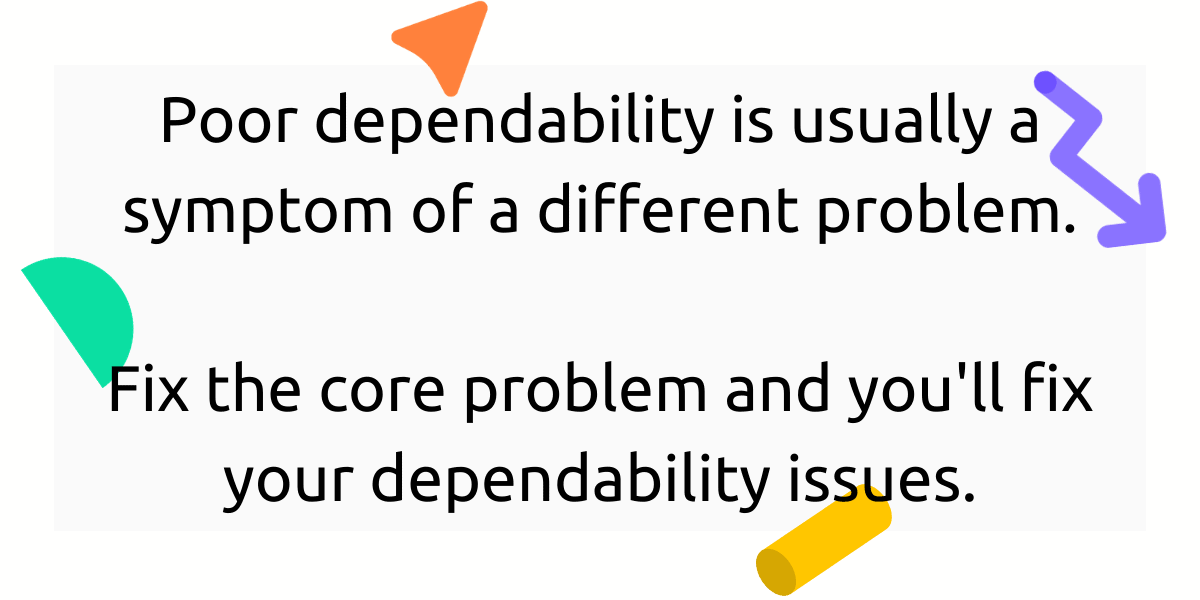
If you’re not reliable, your team loses steam. They’ll hesitate to act because they don’t trust you will follow through.
Dependability is a lot more than just hitting deadlines.
When an employee asks a tricky question, and you say you’ll get back to them later, do it.
If you say you’re always available to talk, don’t turn away an employee who asks for a chat because you’re too busy.
Poor dependability is usually a symptom of a different problem.
Someone who misses deadlines and breaks promises probably wasn’t intentionally lying when they made those commitments. They fully expected to follow through. But time constraints, stress, or just plain forgetfulness changed the plan.
Dependability is about a lot more than just hitting deadlines. It’s about setting and meeting expectations every day.
Become more dependable by building these good habits.
Be realistic
You’ve heard the phrase “overpromise and underdeliver,” right?
When you promise to finish a huge number of tasks, make bold statements about your leadership philosophy, or tell your team that you’re going to accomplish something huge, you’re setting yourself up for failure.
Before you commit to a new project, look at your workload.
Before you declare that you’re following a new management philosophy, think about the implications. What does it mean in practice?
This is tough for people who are in the habit of saying “yes” to everything. However, the alternative isn’t saying “no” instead. You can still agree to take on new projects and help your team as long as you’re realistic.
Have a long to-do list? Don’t blindly agree to add more to it. You can always change your “no” to a “yes” if you have the time.
Next time someone asks you to make another commitment, try this:
Sure, I’d love to do that. Before I commit to anything, let me look at my current workload first. Can you follow up with me next week?
Then practice this next good habit:
Write things down and set reminders
There are simply too many things going on for you to remember them all. Fortunately, you don’t have to.
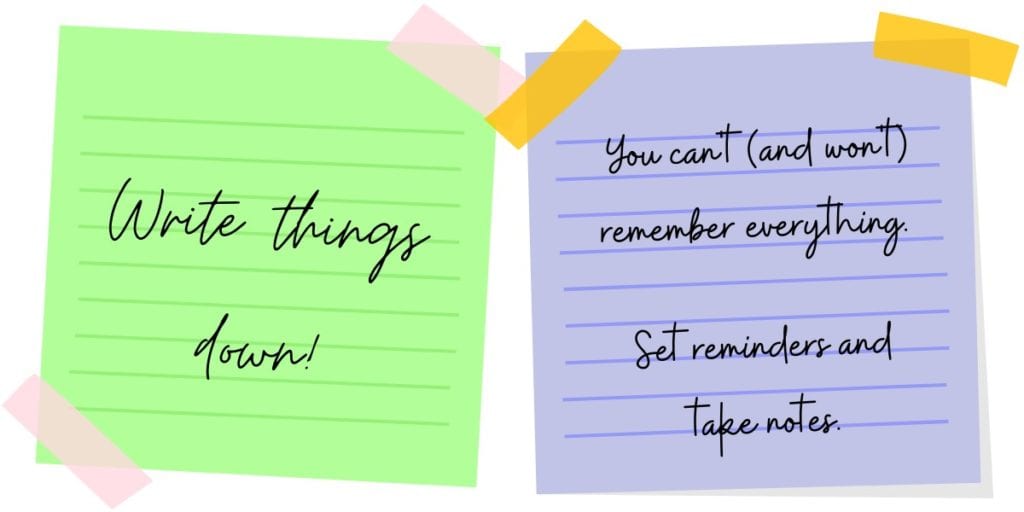
Take notes. Keep things handy if you like to write on sticky notes or a notepad. Your smartphone has a notes function, too.
Set aside time at the beginning or end of each day to review your notes. Set reminders for things that need immediate attention, and file lower-priority items somewhere easy to find when you’re ready. This is an excellent opportunity to delegate.
With everything written down, it’s easier to:
Organize your time more effectively
Organizing your time helps you keep your promises. It also helps you get more done without working longer hours.
There are lots of time management systems out there. Find one that works for you. Here are a few things to try:
- Time blocking: Block out time in your calendar for doing specific tasks. You can use time blocking for personal tasks and work-related obligations.
- Pomodoro technique: Work in focused 25-minute intervals. Take a five-minute break after each work interval.
- Getting Things Done (GTD): Write down everything you want to accomplish within a given time frame. Break down all your goals into actionable tasks.
If you don’t already use time tracking software, you should consider it.
Managing time is a bit of a misnomer — what you’re really managing is the tasks that you finish within that time. It helps a lot when you can see an overview of everything that’s on your plate at the same time.
7. Consistency
Like dependability, consistency builds trust. Your team can count on you because they know what to expect.
You should be consistent with things like:
- Work ethic
- Emotional steadiness
- The way you respond to problems
- Praise
- Availability
When you lack consistency, your team wonders what version of the boss they will get today.
Is this an off day, or are you on your game?
Can they safely tell you about a problem, or will your temper explode?
Ideally, you consistently show good habits. You follow up on messages quickly and are never late for a meeting.
However, there’s value in having consistent weaknesses, too.
If you’re always five minutes late to every call, your team knows what to expect. They’ll plan to get started five minutes late. But if you might be early, late, or on time, it’s stressful and frustrating for the people who have to schedule around you.
Being consistent doesn’t have to mean that you’re always perfect. It means your team doesn’t have to guess what version of the boss they’re getting today.
How to be more consistent
Like most of the management soft skills on this list, building self-awareness is an excellent first step. You can’t fix a problem you don’t know you have.
Most people struggle with consistency in specific areas. For example, you might be great at hitting deadlines but hit or miss when answering messages.
Ask your team about the areas where you are the least consistent.
Then, use these techniques to improve.
Don’t break the chain
Have you ever seen one of those “No Accidents in 592 Days” safety signs? Those are based on this technique.

“Don’t break the chain” (also known as the Seinfeld Method) is a popular productivity exercise. Here’s how it works:
Use a calendar to mark the days when you complete a daily task. If you mark the days with an “X,” you make a chain.
The longer the chain gets, the more dedicated you are to keep it going. You don’t want to break the chain and start back on day one.
This is a valuable technique to build a specific habit. For example, you can mark the calendar every day you keep your meetings to their scheduled time without going over.
It’s not a good tool when working on multiple new habits. Stick to one goal at a time.
If you’re working on a few new habits, try this:
Create and stick to a morning routine
Your morning routine adds structure to your day. It sets the tone and helps create an easier starting point for good habits.
Some people like to tackle their most challenging tasks as soon as they get up. That’s a good option if you’re naturally a procrastinator.
Others prefer to fit some personal priorities into their morning schedule. This makes your job feel like just a part of your day rather than the reason you got out of bed. If you feel burnt out, try this option.
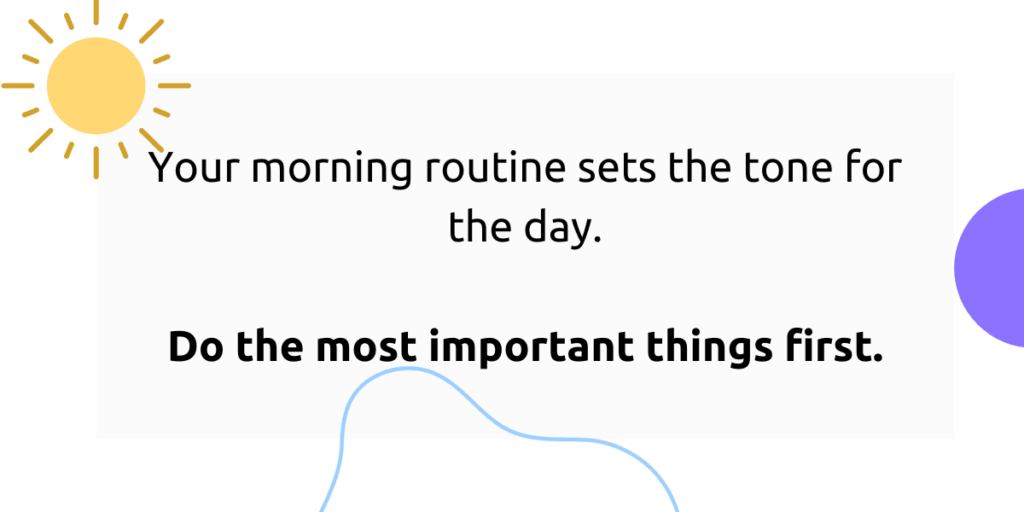
Here are some ways to tweak your morning routine for better consistency:
- Plan your day: Spend 15 minutes in the morning to plan out your day. Organizing your schedule helps you get things done and stick to your priorities.
- Read: Start your day by reading ten pages of a book. After a month, you’ll have read an average-sized book. If you’re working on developing empathy, this is a good time to fit in your reading.
- Exercise: Go to the gym or opt for a home workout to get your blood pumping and prepare yourself for a productive day at work.
- Anything else important to you: Looking to advance in your career? Spend an hour taking an online course. Want to learn to play the piano? Practice for 30 minutes in the morning. Finding time for personal priorities is easier if you do them first.
8. Cultural competence
Cultural competence is a must for leaders in our dispersed world. It’s about understanding and respecting different cultures. Leaders with this skill create inclusive teams where everyone feels valued.
It’s not just about the team; it extends to external relationships, too. Leaders who navigate diverse cultural landscapes build strong professional networks.
Being culturally competent means adapting your leadership style. It’s about fostering open dialogue about differences and creating a workplace that celebrates diversity.
In a nutshell, cultural competence helps leaders thrive in our multicultural world. Those who prioritize it build successful teams and contribute to the broader success of their organizations.
9. Honesty
Your employees are more likely to be honest with you if you’re honest with them.
Honesty helps you build trust and develop meaningful relationships with team members.
Sometimes, honesty is challenging. Those are usually the times when it’s most important.
We recommend transparent leadership. Whether you believe in full transparency or not, it’s vital to be honest with your team.
That means being straightforward when someone asks a question you’re unprepared to answer. Instead of telling white lies, say something like this:
“I’m not comfortable sharing that information with you right now. Here’s what I can tell you…”
A few white lies might not seem like a big deal, but consider this:
Why honesty is so important
Here’s a real example that happened to one of Hubstaff’s team members at a previous job. We’ve changed the names to keep this story anonymous, but the events are real.
Nicole was a rising star within the organization. She was quickly trusted with more responsibility and gained a reputation for efficiency and a great work ethic.
Nicole was offered an important promotion and a significant pay raise when the company decided to restructure. She just needed to wait a couple of months until the budget was finalized for the following year.
Nicole started reporting to a new boss, Jenn. Jenn set up weekly meetings to talk about performance and priorities. Each week, Jenn gushed about how well Nicole was doing.
But when Nicole was asked to represent the company at an important event, Jenn said that Nicole wasn’t performing well enough to take a week off of her regular job to work on a special project.
Nicole was blindsided. This was the first time that performance issues had ever been mentioned.
She asked for details and discovered that Jenn was disappointed that Nicole hadn’t worked on specific side projects. Jenn had mentioned them before but said they were low priority and shouldn’t take time away from more important things. Nicole proposed a new action plan to make sure that Jenn was satisfied with the work being done.
For several weeks, Nicole used the weekly check-in meetings to ask about priorities and ensure she was working on the right things. Jenn assured her that all the problems were solved, and she couldn’t be happier with her performance.
Then, Nicole found out that she wasn’t going to be offered the promotion and raise that were discussed before. Probing, she found that Jenn reported that she didn’t take enough initiative and was performing poorly.
Nicole immediately began seeking a new job somewhere else. She was offered a position on a different team within the company, but it was too late. All trust was gone.
The company lost a top performer because a manager wanted to avoid uncomfortable conversations.
Get better at honesty by working on your tact
People often avoid telling the truth because they don’t want to hurt someone’s feelings. This is especially tough for empathetic people.
Remember this: being honest with an employee might hurt their feelings for a few minutes, but not being honest with them hurts their career and future.
Keep your team’s best interests in mind and temper your honesty tactfully. Put simply, tact means sensitivity to other peoples’ feelings.
Tact makes it easier for you to share feedback. It also makes it easier for the other person to hear it.
Here are a couple of ways to be more tactful:
- Choose the right time and place: It’s harder to hear criticism in front of others. Share feedback privately, and whenever possible, speak face-to-face. Be mindful of how you ask for a meeting, too. If you publicly ask someone to stay after a meeting or pull them away from a group for a private conversation, they might feel like you’re announcing they’re in trouble.
- Use the sandwich approach: When you need to say something the other person doesn’t want to hear, it helps put it in context. Start and end with something positive. Instead of saying, “You’re missing a lot of deadlines,” the sandwich approach sounds like this: “I’m pleased with the quality you’re delivering. You’re missing a lot of deadlines, and we need to fix that because your work is significant to the team.”
- Offer support: As a manager, you’re there to help. Maybe you can show your employees a time management technique to try or suggest solving a tricky problem. In some situations, offering emotional support is more consequential.
10. Critical thinking
How many decisions do you make?
According to research, adults make an average of 35,000 decisions every day. Those choices range from little things (like whether or not to have a second cup of coffee) to significant business decisions.
That’s why critical thinking is so important. As a manager, the decisions you make impact everyone at your company. Problem-solving skills are critical in a business environment.
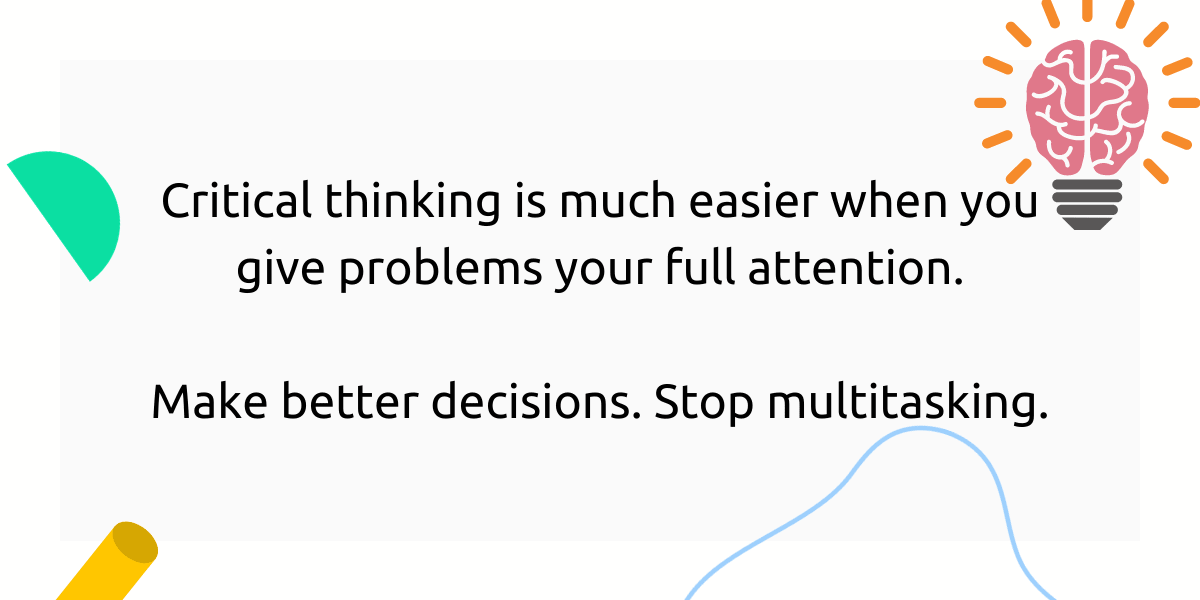
We tend to think of decisions like a fork in the road. You can choose option A, option B, or option C.
In real life, most problems aren’t multiple-choice. It’s much more complex. You need to be able to:
- Recognize a potential challenge, opportunity, or choice
- Decide whether or not you need to act
- Decide if you need to act now or wait until later
- Evaluate possible choices
- Consider what is likely to happen after making your decision
You can get better at critical thinking with practice. Often, you just need to give a problem your full attention.
On top of that, you can make better decisions by rooting out your own cognitive biases.
Avoid cognitive biases to improve your critical thinking skills
A cognitive bias is an error in thinking. It occurs when your brain tries to process information in a simpler way.
Here are some of the most common cognitive biases you should keep in mind:
- Actor-observer bias: You attribute your actions to external causes, but for others, you blame internal causes. For example, if you forget about a meeting, it’s because you have too many other things to do. If your employee forgets about a meeting, it’s because they’re forgetful or lack time management skills.
- Anchoring bias: You’re likelier to believe the first thing you hear. This forces you to interpret any new information from the reference point of the first piece of information (i.e., the anchor). Imagine that your supply order is incorrect. Mel tells you that James was in a hurry and probably submitted the order incorrectly. That information is now the anchor — when you talk to James, you ask if he rushed the order and made a mistake. Without the anchor bias, you would have objectively asked James what happened without reference to Mel’s story.
- Confirmation bias: It’s easier to believe information if it confirms something you already believe. You see this often in politics, but it’s common in the workplace, too. Let’s pretend you need to choose a new email platform for your team. You used Program A at a previous job and liked it a lot. To save time, you ask an employee to evaluate a few choices and send you the pros and cons of each. When you look at the list of benefits, the list for Program A will carry more weight because it confirms your belief that it’s good software.
- Halo effect: We all tend to link certain pieces of information together. If someone is well dressed, we’re more likely to assume they’re educated, affluent, and professional. The halo effect causes you to make assumptions about people based on limited information. This bias can be tricky. You might be more likely to give extra work to your female employees because you associate being a woman with the ability to multitask. At an interview, you may pass over a great candidate because something in his appearance makes you think he’s too traditional and closed-minded. Since these associations are subconscious, it can be challenging to recognize this bias.
11. Confidence
When you’re a confident leader, you find it easier to make decisions. You’re less anxious, more assertive, and find it easier to influence others.
Confidence is about more than the way people see you.
Sure, it’s crucial that your employees, peers, and others feel that you’re a confident leader. The more they see that you trust yourself, the more likely they will trust you.
But that’s only half the story. When you are confident in yourself, you have an easier time doing your job. You’re not anxious about what might go wrong because you know you have the skills and smarts to adjust if things don’t go as planned.
You make better decisions when you’re confident you can handle the outcome, even if it doesn’t go as planned.
Grow your confidence with these tips:
Work on yourself
If you often feel like you’re not good enough, work on improving yourself. Dedicate 30 minutes to one hour every day to self-improvement.
Find some work-related books, podcasts, or courses that can help you improve your job.
You can focus on a specific skill (like the ones we listed in this post) or, more generally, on growing as a leader. John Maxwell has many great resources to help you upgrade your leadership ability.
Invest time and grow outside of work, too. As you tackle a new hobby or build a new skill, you’ll prove that you can still learn and accomplish hard things. That’s a huge confidence builder.
Avoid negative self-talk
People who aren’t very confident often talk down to themselves. This type of negative self-talk doesn’t do your confidence any good.
It can also increase your risk of mental health problems.
To avoid negative self-talk, try to catch yourself when you’re self-critical. Don’t say things to yourself you wouldn’t say to a good friend.
Speaking of good friends, they can help you work on this. Ask the people you trust to point out the negative things you say about yourself. They know all of the best things about you, and most of them care enough to help.
Write down your achievements
If you were promoted to a manager, you must be doing something right.
Writing down your achievements can come in handy later. You’ll have an excellent resource if you need to update your resume, write a speaker bio, or mention your accomplishments in some application.
Write down all your achievements and qualities. Review this list daily to boost your confidence, and add to it when you achieve something new.
This can help train your brain to focus on more positive things. Rather than thinking about what you did wrong, you consciously and subconsciously learn to look for the things you’re doing right.
Remember, there’s no such thing as a perfect manager. The most confident managers aren’t the ones that make the fewest mistakes. They’re the ones that accept their mistakes, fix them, and move on.
12. Networking
Networking is a game-changer for leaders. It’s about building and maintaining professional relationships inside and outside your organization.
Good leaders know that networking isn’t just about business cards; it’s about genuine connections. They take the time to understand others and make meaningful interactions.
External relationships matter just as much. Leaders who excel at networking broaden their horizons, gaining insights and support from diverse professionals.
Adaptability is key in networking. Leaders who can navigate different personalities and industries create opportunities for themselves and their teams.
Networking is not just about who you know; it’s about fostering meaningful connections that bring value to you and your organization.
What else?
There are lots of skills we didn’t talk about in this list. As a leader, it’s worth your time to work on:
- Authenticity
- Humility
- Organization
- Goal setting
- Charisma
- Kindness
What soft skills do you think are the most important for a manager? Let us know in the comments what the right soft skills for managers to focus on are.
Subscribe to the Hubstaff blog for more posts like this
Most popular
The Fundamentals of Employee Goal Setting
Employee goal setting is crucial for reaching broader business goals, but a lot of us struggle to know where to start. American...
Data-Driven Productivity with Hubstaff Insights: Webinar Recap
In our recent webinar, the product team provided a deep overview of the Hubstaff Insights add-on, a powerful productivity measurem...
The Critical Role of Employee Monitoring and Workplace Security
Why do we need employee monitoring and workplace security? Companies had to adapt fast when the world shifted to remote work...
15 Ways to Use AI in the Workforce
Whether through AI-powered project management, strategic planning, or simply automating simple admin work, we’ve seen a dramatic...





